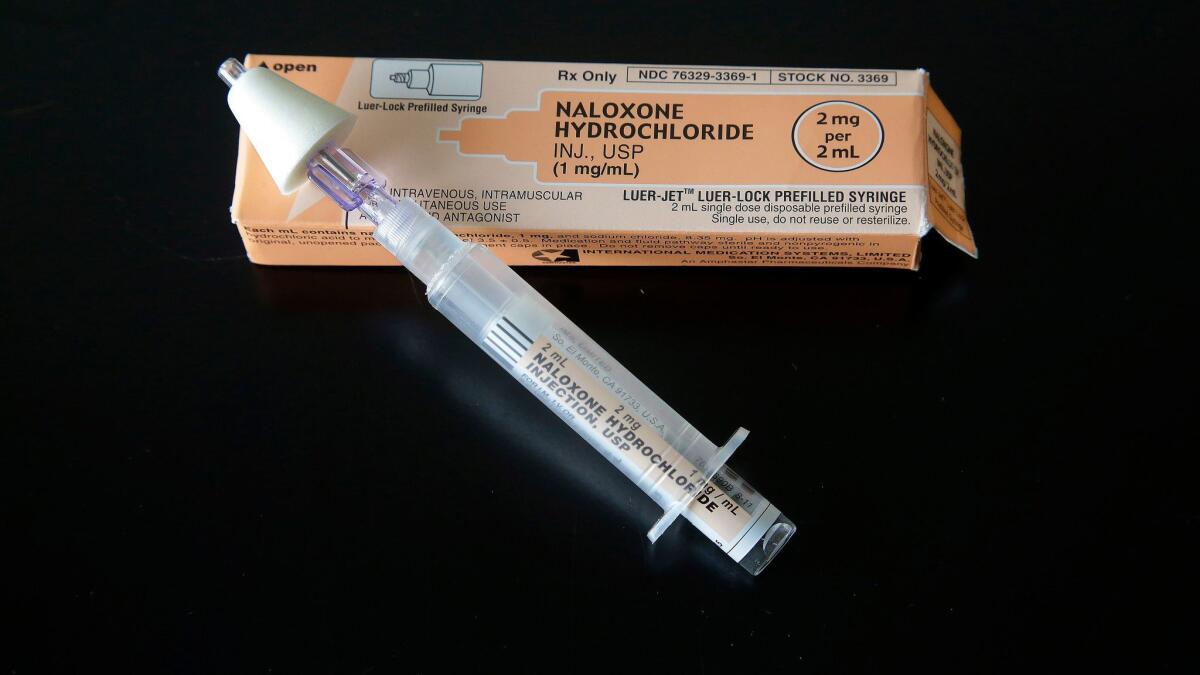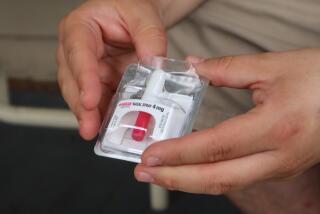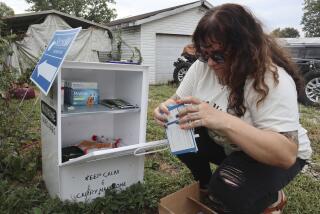With opioid epidemic raging, calls grow for cheaper access to heroin overdose-reversing drug

Reporting from Chicago — When the American Medical Assn.’s annual meeting convenes in Chicago on Sunday, the powerful physicians’ lobby could push for government intervention to lower the price of the heroin overdose-reversing drug naloxone.
A resolution written by a Michigan doctor and three medical students notes the skyrocketing cost of the drug — a two-pack of auto-injecting syringes went from $690 in 2014 to more than $4,000 this year, while other forms of the drug have doubled in price — and calls on lawmakers and regulators to increase public access to affordable naloxone.
“The population I serve often has difficulty affording medications for chronic illnesses that they require daily, so the idea that they would be able to purchase an increasingly costly overdose reversal medication would certainly be out of the question for them,” said Dr. Gunjan Malhotra, who works in Detroit.
But in a sign of the labyrinthine and confusing world of drug pricing, some Chicago-area groups that distribute the antidote say they get it free from the manufacturers or at very little cost, while others say they pay dearly.
“It really seems like one of the most important tools (to fight overdoses) is getting naloxone into the hands of as many people as possible; raising prices will not help us,” said Gabriela Zapata-Alma of Thresholds, a mental health agency that pays $250 for a three-dose kit of naloxone that comes in the form of a nasal spray.
A spokesman for Adapt Pharma, which makes the Narcanbrand nasal spray, says the company offers two-packs to nonprofit groups for $75.
Naloxone reverses the effects of a heroin or narcotic painkiller overdose, and as America’s opioid epidemic has exploded over the last 20 years, it has become a front-line defense for people with little or no medical training.
Police officers across Illinois have stopped dozens of overdoses after they started carrying the kits, and naloxone is now commonplace in schools too. Organizations like the Chicago Recovery Alliance put the drug in the hands of heroin users and their friends and family.
Dan Bigg, head of the alliance, says the group has given out around 300,000 doses over the last 21 years, and that he has received more than 11,000 reports of overdose reversals in that time. The alliance distributes the cheapest form of naloxone — a vial of the drug and a syringe — which Bigg says he gets at a reduced cost from the manufacturer (at the company’s request, he wouldn’t reveal the price).
“Anyone can come to us and get the low-tech, cheapest option,” he said. “I’ve never heard of anyone being too squeamish to use the needle in an emergency.”
Chelsea Laliberte, whose Live4Lali nonprofit does similar naloxone distribution, says she has been able to get the drug free via drug company grants. But the nonprofit is expanding its efforts this year, and has begun to pay for naloxone.
She, too, wouldn’t discuss the exact price, but said it was under $20 per dose.
“We’re only willing to pay for what is the most viable, sustainable option, which is a syringe and vials,” she said. “We don’t pay $4,400 a kit for [auto-injectors]. I would never do that with anyone’s donation dollars.”
The auto-injector, sold under the brand name Evzio, is made by the drug company Kaleo. The device contains a recording that guides users through the process with voice commands. Kaleo says that in a study performed by its employees, 90% of people were able to use the Evzio successfully without training, while no one was able to administer the nasal spray correctly.
The company has donated thousands of units to various groups; one recipient is the Lake County, Ill., Health Department, which distributes its haul to local police departments.
Despite the high list price, which does not take into account negotiated discounts and rebates, a Kaleo spokesman said patients with commercial insurance and uninsured people making less than $100,000 pay nothing for the device. People paying cash can get it for $360 by calling a hotline, he said.
Those without insurance or a prescription can still buy naloxone at a drugstore. Walgreens says the cash price is $20 for a generic, single-dose vial and syringe, or $40 for a generic nasal spray; CVS says the uninsured pay $45 for a two-dose injectable version and $110 for Narcan brand nasal spray.
Researchers who examined the rising price of naloxone wrote in the New England Journal of Medicine last year that the cost might have contributed to the relatively slow adoption of the drug. Between 2009 and 2015, they wrote, naloxone prescriptions increased from 2.8 million to just 3.2 million, as opioid overdose deaths rose from 20,000 to 33,000.
Researchers have called for the federal government to take steps that are reflected in the AMA resolution, including negotiating cheaper prices with drug companies and making naloxone an over-the-counter drug, which would cut prices by attracting new manufacturers.
The AMA will hold a committee vote on the resolution Sunday, and if it passes, delegates will debate and vote on it later in the week.
Though the measure holds no force of law, Malhotra and her colleagues say they hope it will be a strong advocacy statement.
“This tells legislators and citizens across our country that America’s physicians think we can do more to fight the opioid epidemic,” said Eric Walton, a student at the Wayne State University School of Medicine. “Naloxone affordability is a common-sense step toward ending opioid-related deaths.”
Keilman writes for the Chicago Tribune.
Twitter @JohnKeilman
ALSO
Benadryl or Quaaludes? Lawyers jostle over what drugs Bill Cosby gave Andrea Constand
To curb opioid epidemic, California bill would tax painkillers to fund treatment
How a 5-sentence letter helped fuel the opioid addiction crisis
More to Read
Sign up for Essential California
The most important California stories and recommendations in your inbox every morning.
You may occasionally receive promotional content from the Los Angeles Times.










